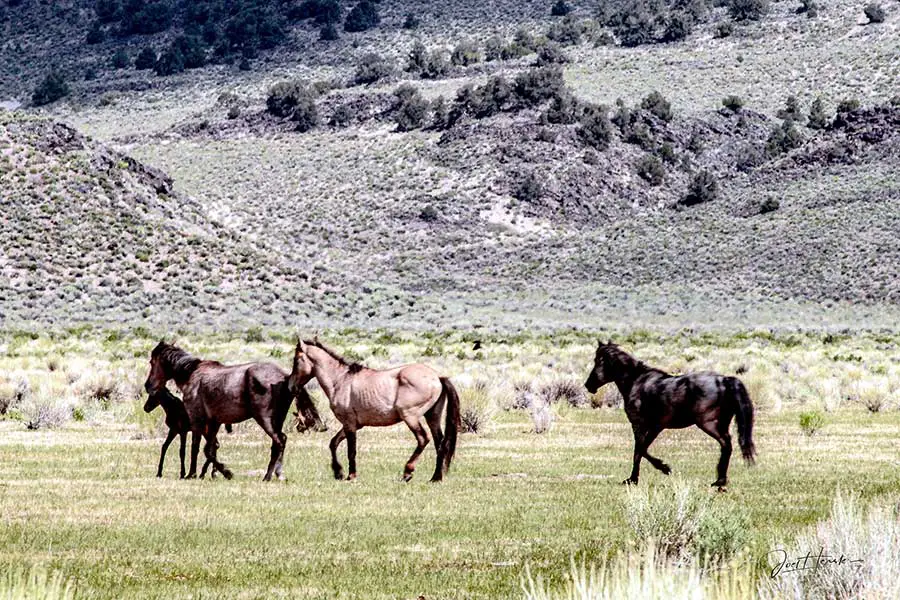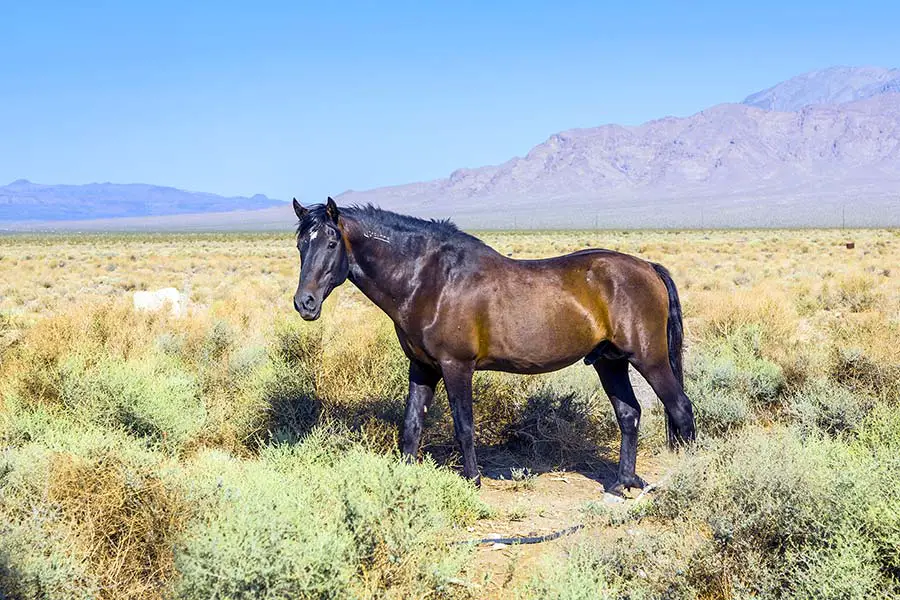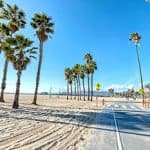
When you imagine California, what do you picture? Sunlit beaches? Leisurely road trips? Maybe a spectacular sprawling vineyard or two? Wild horses roaming through the countryside? But wait, does California even have wild horses?
California does have a growing population of wild horses that thrive and roam the vast protected lands of the Golden State. These magnificent horses are descended from those brought by the early Spanish settlers or from domesticated stock from pioneer farms or ranches.
So, where exactly can we see these regal creatures? Do they wander the countryside in massive herds? How many of them are there? Do they have any predators? If so, what are they? In the next sections, you will find out the answers to these questions and more.
A Brief History of the Wild Horse in California
Some of the wild horses of California originally came with Spanish settlers in the 16th or 17th century. They are not a native American species, but they are a big part of our culture. Later the herds grew when farm and ranch stock combined with the herds.
In fact, just before World War 2, the population of the wild Californian horse was declining. Then, a few decades later, the federal government stepped in to help.
In 1971 President Nixon passed a law declaring horses were “living symbols of the historic and pioneer spirit of the West.” This law stipulated that the Bureau of Land Management (BLM) and the U.S. Forest Service must manage and defend free-roaming horses (and some cute burros) on protected U.S. lands. These protected lands are called Herd Management Areas, or HMAs. They are one of many examples where the government has become involved in California’s ecosystem.
Where do Wild Horses Live in California?
Now that we know more about the HMAs, where do we find the horses? The Bureau of Land Management has several HMAs with land in multiple states throughout the west. Below is a list of specific HMAs with territory mostly on Californian land, except for Twin Peaks since it’s so vast and extends into Nevada.

Here they are, listed alphabetically:
- Centennial
- Chicago Valley
- Fort Sage
- Lee Flat
- New Ravendale
- Red Rock Lakes
- Twin Peaks
Centennial
One of the larger areas at over 300,000 acres, Centennial, is mainly on the China Lake Naval Weapons Base in Kern County, 10 miles north of Ridgecrest.
The herd is thought to descend from generations of ranching stock and tends to display blazing solid colors. The horses vary in size from 14 to 16 hands and weigh between 900 to 1100 pounds.
If you plan on looking for these horses, be careful. This herd is in the Mojave Desert ecosystem. The Mojave National Preserve is actually home to an inactive volcanic field.
While there shouldn’t be any lava erupting, remember that the desert’s temperature is brutally hot. It’s known for being the location of the hottest temperature recorded on Earth. (130 degrees!)
Chicago Valley
The Chicago Valley Herd Management Area is found in southeastern Inyo County, California, and comprises over 270,000 acres. These lovely chestnut, bay, black and brown horses are well-supervised by the Bureau of Land Management near Death Valley Junction, and they add some excitement to the journey when on your trip to Vegas to do a little gambling.
The horses found here are believed to descend from local ranching stock as well. The area’s topography is similar to Centennial, and it’s dominated by playas or dry lake beds and Joshua trees.
Fort Sage
You will find Fort Sage about fifty miles up 395 from Reno, Nevada, and 40 miles southwest of Susanville, CA. Fort Sage is known for its HMA and 9,000 acres of land managed for motorcycles and ATVs.
After you’re done off-roading, be sure to locate this small herd of about 30 animals. This mix of mares, stallions, and their young probably originated decades ago from runaway ranch stock.
New Ravendale
New Ravendale HMA rests near the town of Ravendale, CA, in Lassen County. It is bordered on the east by Highway 395. The mustangs here probably also descended from local ranching stock.
These horses share traits with a bunch of breeds and display draft horse characteristics in rich chestnut, glistening black, and solid bay. They’re a tall bunch, too, measuring at 15-16 hands.
Bay Area Answers Fun Fact: Horses can see about 350 degrees and have some of the biggest eyes of any mammals on land.
Other Posts of Interest
- Does California Have Bears? (And Where Do They Live)
- Are There Sharks In San Francisco Bay?
- Is Gold Still Found in California? (Where To Look)
- Does San Francisco Have Seals Or Sea Lions?
Red Rock Lakes
Red Rock HMA rests in the shade of Mahogany Mountain and is found 10 miles east of Macdoel, CA, in northern Siskyou County. It spans about 18,000 acres.
Red Rock Lakes’ horses seem to have the most razzle-dazzle lineage yet. This herd most certainly traces its roots to Spanish mustangs and boasts several spotted Appaloosas, the horse of the Nez Perce tribe. However, most of these horses are stocky as the pioneering ranchers’ horses diluted the original Spanish blood.
Twin Peaks
The wild horses of the Twin Peaks HMA are located in Lassen County, in Northern California. When you get there, you will be amidst the majestic mountains, flat valley floors, and sweet-smelling brush.

Once you see the horses, you will notice among the stunning black, chestnut, pinto, and Appaloosa horses adorable long-eared burros and mules. This area is one of the few HMAs where wild mules live beside the mustangs and burros, and seeing them in the wild is a memorable experience.
If you’re traveling with a history buff, this might be the HMA to visit. The horses of this plentiful herd have Spanish descent like some of the others I mentioned. But this herd has something else. These horses descended from Army Cavalry horses released around World War I.
Where is the Best Place to See Wild Horses in California?
So how can you see them? That takes some planning and depends on your preferences. The first thing you should do is check out a California topo map to review the topography of the area you plan to visit. Next, ask yourself the following questions:
- What type of terrain am I comfortable navigating?
- What breed of horses am I interested in seeing?
- How much time do I want to give to pursuing the horses?
These questions might shed some light on what HMA you are willing to visit. For example, Death Valley and The Devil’s Garden might be someplace you avoid if searing heat or sharp rocks aren’t your cup of tea. On the other hand, the horses of Montgomery Pass are beautiful but sometimes take days to find because of their remote location.
So contacting the BLM is the best bet. Most of the terrains -for either residents or tourists- will challenge you at times. You might also go where their population is most dense, which brings us to another question. Just how many horses are in California after all?
How Many Wild Horses are in California?
We mentioned earlier that the population of wild horses in the U.S. bottomed out enough for the federal government to intervene in 1971. At that time, the horse population in the country was 25,000.
These days the number has soared to over 70,000, with over 7,300 of them roaming approximately 2.5 million acres of Californian soil.

Do Wild Horses Have Predators?
It’s not surprising that the population has skyrocketed. Most wildlife populations are controlled by two factors: hunting and predation, not so with horses.
First of all, there are no horse slaughterhouses in the United States. Second, in 1998, California voters made it illegal to sell horsemeat for humans to eat. The state ballot measure also banned the slaughter of horses for human consumption. So that eliminates one threat.
But what about predation aside from us humans? Again, there isn’t much to worry about for the horses. Predators like bobcats and coyotes often share the wild horse’s land but aren’t a real threat. Coyotes hunt in packs, so they might prove a danger to foals but will rarely take out a grown adult horse.
The only real threat seems to be the mountain lion. The horse population in Montgomery Pass, for example, has been managed by regular patterns of mountain lion predation for the past 30 years.
There hasn’t been a single roundup of this herd in that time. The mountain lions seasonally hunt about 70 foals or deer. It’s a beautiful example of mother nature taking care of herself without human intervention.
California: Where the Wild Things Are
If you’re a lifelong resident or just visiting for a few days, the horses of California are waiting for you. The draft horses, ranchers, and Appaloosas are all welcome sights after the traffic or hustle that comes with the urban attractions.
Whether you brave record-breaking heat or navigate a remote mountain pass, the wild horses of the Golden State are sure to liberate your spirit.





